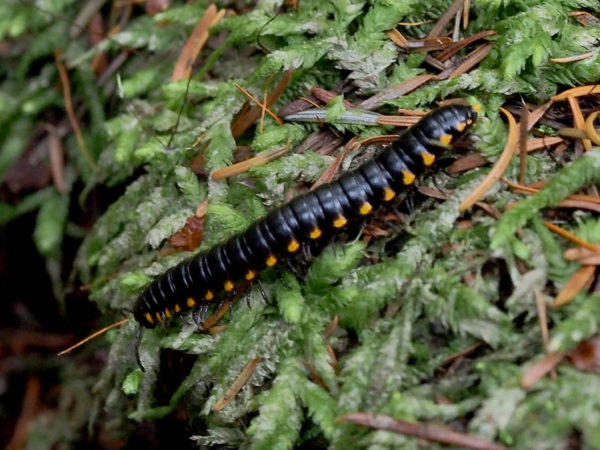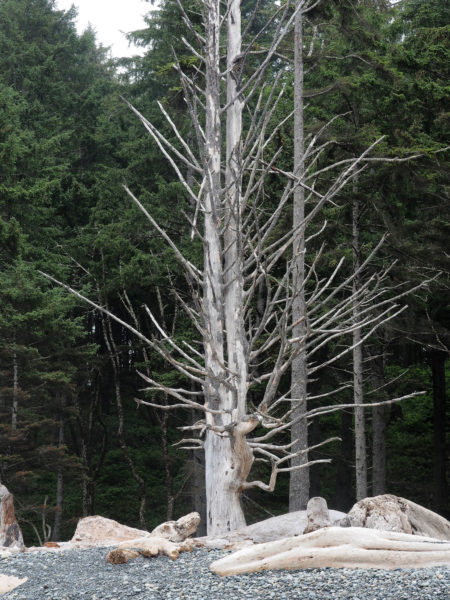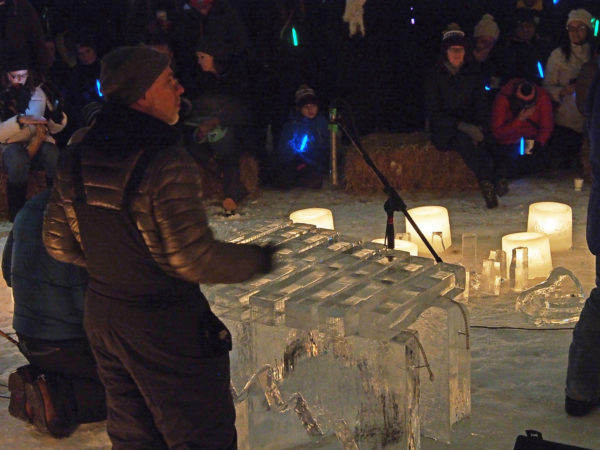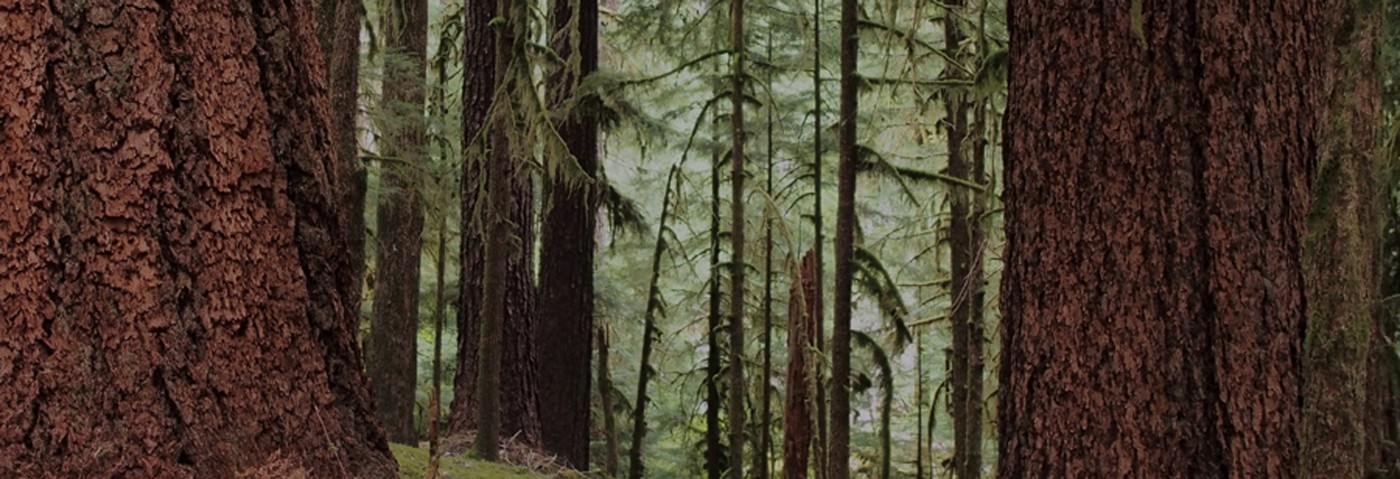A World of Molecules
By John Palka — Posted March 3, 2019
Both living things and the non-living world consist of molecules. The molecules that make up each one of us are largely the same as those that make up every other person and animal on the planet. Molecules make up everything in the world of our experience. “Reductionist science” is sometimes criticized for not recognizing the holistic nature of the world, but what understanding could be more holistic than the understanding that we are all made of the same stuff, and need the same stuff to sustain our lives!
Let me put an exclamation point on this concept through a few photographs.

A barred owl (Strix varia, Family Strigidae) perched on a box elder (Acer negundo, Family Sapindaceae) as seen from the balcony of our town house in Minnesota.

A yellow-spotted millipede (Harpaphe haydeniana, Family Xystodesmidae), a common denizen of the moist forests of the Pacific Coast of North America, seen here in the old growth forest of Deception Pass State Park on Whidbey Island, Washington. These striking creatures play an important part in breaking down leaf litter, recycling its organic components for use by other organisms.
The owl and the millipede are both made of billions upon billions upon billions of molecules, with much the same kinds of molecules found in both organisms. There are differences, of course, but the differences are tiny compared with the similarities. The tree that the owl is perched on and the moss that the millipede is crawling on and the hemlock needles scattered on the moss are also made largely of the same molecules. There are greater differences between the molecules of plants and those of animals, but everything you see in these pictures is made of molecules—as are you, and your beloved if you have one, and your children if you have them, and the water you drank today, and the air you felt on your skin. The world we know and experience and live in is made of molecules, and the processes of life itself are at heart interactions among molecules. If we ever find living organisms on another planet, they will be made of molecules, too.
WHAT IS A MOLECULE?
Instead of an abstract definition, let’s consider a specific example. We have previously looked at one kind of molecule in some detail—water. Our starting point was the chemist’s understanding that each water molecule is composed of three atoms: two atoms of hydrogen and one of oxygen (hence the famous formula H2O).The properties of these three atoms give water molecules their shape, an arrowhead with oxygen at the tip and the two hydrogens forming a two-pronged tail. In addition, the properties of the atoms give water molecules a polarity—water molecules are slightly negatively charged at the oxygen tip and slightly positively charged at each hydrogen tail. Because opposites attract, specific parts of the surface of a polar molecule like water attract and are attracted by specific parts of other polar molecules. This keeps water molecules near each other when water is liquid and arranges them into crystals when water freezes. It takes heat energy to overcome this attraction of water molecules to each other—it takes heat to convert ice into water and water into steam or water vapor, and the withdrawal of heat (in other words cooling) to go in the other direction.
These properties of water are elementary, but they illustrate a number of important general points:
- Molecules are composed of atoms.
- Molecules have shapes.
- Molecules can be electrically charged, and the charges are distributed in specific ways over the molecular surface.
- The electrical charges on molecules lead to inter-molecular interactions.
- Energy affects intermolecular interactions.
These deductions from a simple molecule like water are applicable to far more complex molecules. All molecules have shapes, many of them have electrical charges, they interact with one another, and they respond to the input or withdrawal of energy. In short, molecules are highly dynamic entities.
MOLECULES THAT BUILD STRUCTURES
We have many times looked at trees, marveling at how they’re shaped, how they carry out photosynthesis, how they transport water upward, how they grow straight up against the pull of gravity, and how they interact with the myriad inhabitants of the soil, especially the mycorrhizae.

A Sitka spruce (Picea sitchensis, Family Pinaceae), part of the silver forest along the shore of Rialto Beach on the wilderness coast of Olympic National Park, Washington. Because much of the bark has peeled off, indications of the vertical grain of the wood can be seen.
In these earlier explorations, we have taken the molecular construction of trees for granted. This time, let’s focus our attention precisely on this aspect of these awe-inspiring companions of ours on planet Earth.
We know from experience that trees are strong. They stand up to the wind, and it takes a lot of work to cut them down. We also know that they store a lot of energy, for if we burn their wood, we get a lot of heat from their flames; that heat energy was previously stored in chemical form in the wood. Molecules are the basis for both the strength of trees and the energy they store.
Cellulose is the major constituent of the walls of all plant cells. Like starch molecules, cellulose molecules are long chains of sugar molecules, mainly glucose, held to one another by chemical bonds. The glucose molecules were originally produced by the process of photosynthesis which is driven by sunlight. So, the heat energy that a wood fire gives us originated from the Sun. This energy was placed in temporary storage in the structure of the cellulose and other molecules of which the wood is made.
Why is wood so strong? What holds the cellulose molecules together to build a structure that can be 20 stories high and resist gale-force winds? Chemical bonds. A single cellulose molecule is composed of a chain of hundreds to thousands of glucose molecules held together by chemical bonds. These are linked to neighboring cellulose molecules by additional chemical bonds, thus forming cellulose microfibrils. And microfibrils are held together as well, apparently through the aid of additional molecules like hemicelluloses, pectin, and lignin.
All this bonding makes cellulose not only strong but also hard to digest. We humans can’t do it. Some animals, such as cows and other so-called ruminants, are able to digest cellulose, but only with the aid of bacteria that live in special chambers of their guts and release appropriate digestive enzymes, cellulases (also molecules!). This bacterial digestion breaks the chemical bonds between the sugar molecules that make up cellulose, and thereby releases the glucose molecules into solution. Following absorption across the gut wall, the host animal can use the glucose as a source of metabolic energy.
MOLECULES THAT GENERATE MOVEMENT
Let me tell you a story. Early in February of each year, the denizens of the Twin Cities of Minneapolis and St. Paul get to enjoy the Luminary Loppet. Here is how Minnesota Public Radio (MPR) describes it: “Perhaps the Twin Cities’ most magical event all year is the Luminary Loppet, a highlight of the urban cross-country ski festival’s string of winter events. As night falls, a groomed course around Minneapolis’ Lake of the Isles is serenely edged by hundreds of spaced ice lanterns, each enclosing a lit candle. Along its glimmering way, the course leads skiers and walkers to bonfires and illuminated ice structures, fire dancers and fairyland woods clustered overhead with tiny flames. The Luminary Loppet nods here and there to pagan themes but mostly seeks to celebrate the quietness and darkness of winter, as well as an element central to Minnesota’s soul — water.”
The Luminary Loppet on the Lake of the Isles in Minneapolis, Minnesota: Ice luminaria line the walking/skiing trail along the edge of the lake and various nooks and crannies that the participants are invited to explore.

The Luminary Loppet on the Lake of the Isles in Minneapolis, Minnesota. Ice luminaria line the walking/skiing trail along the edge of the lake and various nooks and crannies that the participants are invited to explore.
For about a decade now, my wife, Yvonne, and I have been enjoying the annual Luminary Loppet, along with some five thousand others. The lovers of the Loppet range in age from toddlers, and sometimes even infants—bundled up and pulled on plastic sledges by exhilarated parents—to oldsters like us in their eighties or more. Depending on the snow conditions, there are more walkers avoiding slipping by putting Yaktrax on their boots, or more skiers gliding along the multiple tracks set in the snow earlier in the day.
What does all this have to do with molecules? Everything you can see at the Loppet—every breath you take, every sip of hot chocolate or of beer, every mug and every glass, every movement of every muscle, every flickering candle, everything!—reflects the dance of molecules.
This year the scene was marvelously rich. As Minnesota Public Radio wrote, “Along with an ice forest—a Narnian grove of 100 7-foot-tall ice spires participants can stroll among—there was music performed solely on instruments carved from ice.”

The ice orchestra included ice drums, ice horns, and assorted other instruments, including this ice xylophone.
“The instruments, sometimes together with voices, included ice xylophones, drums, tubaphones, udus, horns, whistles, and shakers.”
In this post we have a perspective on this festive scene that MPR and most people on the spot surely did not have—the understanding that everything you can see in this portrait of the musician and his ice xylophone was the outcome of the structure and properties of molecules.
HOW MOLECULES PRODUCE MOVEMENTS
In the text above, we explored how molecules assemble to produce supramolecular structures. Now, let’s think about how they produce movement.
The cells of a muscle are packed with two sets of microscopic filaments: thin filaments composed of actin molecules and thick filaments composed of myosin molecules. The molecules within a filament are held together by intermolecular forces, just like those of cellulose. The filaments are all accurately aligned and spaced, so that each myosin filament is surrounded by six actin filaments. Each individual myosin molecule has a tiny, tiny projection called a head sticking out toward the nearest actin filament. Now comes the amazing part. Every movement, every shortening of a muscle, is produced by the pull of its myosin filaments on its actin filaments via those myosin heads.The heads of the myosin molecules move forward and backward, attaching to the nearby actin molecules during one part of the movement cycle and releasing during the rest. So, the shortening of your biceps, or any other muscle, is produced by the swinging back and forth of the heads of individual myosin molecules that are far too tiny to be seen, even through an ordinary microscope! When this power swinging occurs and when it stops is controlled by two additional types of protein molecules on the surface of the actin filaments, as well as calcium. Here is an excellent, albeit somewhat technical, explanation of this cycle, together with a very vivid animation: https://www.youtube.com/watch?v=BVcgO4p88AA&vl=en.
Where does the energy for this pulling of myosin on actin come from? Molecules! Small molecules, called ATP for short, transfer energy that originated in the molecules of the food you ate to the myosin molecules so they can pull on actin. And where did the molecules of your food get their energy? Ultimately from the sugar molecules made by plants. And where did the sugar molecules get their energy? From the light of the Sun that was initially captured by chlorophyll molecules. And where did the Sun get the energy to pour out as light and other radiation? From molecular reactions in its interior that release energy in the form of radiation. Through this chain of molecular reactions, the contraction of your muscles is driven by the Sun!
OUR MOLECULAR WORLD
The structures of our world, the movements all around us, the endless transformations of energy from one form to another, the processes that constitute life—all these are made of or depend on molecules or atoms. All of them.
To me, this is a profound understanding. Life on Earth is interconnected and interdependent in an ecological sense, as we have seen before. Organisms are born, die, and decompose. They nourish one another. But underlying all these organismic interrelationships is the ubiquity of molecules. We are truly made of molecules and live in a molecular world!
When you next move your finger, or go for a walk, or eat a meal, or spend time with your family, or sit on a chair, or touch the screen on your cell phone, remember that all these amazing components of your world are made of molecules, every movement is generated by molecules, and the energy to both build and move is stored in and released from molecules. Explore how this realization affects your experience. You may be surprised!



Wonderful post, Johnny! Wow, I have never heard of the luminary loppet! Would love to see it some day. Back here in Minnesota on a frosty, beautiful March morning tending to my mother for a time.
Thanks, Ann. The Loppet has been running since 2002, I believe, and the whole event, including a full suite of races over several days, draws something like 10,000 participants and 20,000 spectators. It’s truly a gem! Welcome back to Minnesota and its glorious winter days. I hope that being with your mother is a rewarding experience for both of you.
Great essay as usual, and gorgeous photos!
Thanks, Sue. Come for the Loppet some time and you can enjoy the real sights and sounds, not just photos. It really is a thrilling event!
Wonderful Johnny… Another enjoyable nature course..!! Thanks much
Thanks, Marty. I love exploring ideas that tie things together!
Wow-I really enjoyed the overall message and then that video! I will think of this with appreciation for every twitch and turn! Your explorations take us on wonderful walks through our world.
Thanks, Pastor Chris. I well remember when I first learned about how myosin filaments pull on actin filaments. I was an undergraduate back then (wow, 1958!). The idea was brand new (introduced only in 1954) and still controversial, and I found it intellectually exciting. Now I find it awe-inducing!
I’ve had two kinds of responses to the molecular basis of everything (non-living as well as living) over the years. One is the preciousness of the arrangement we call living organisms, and the other is, as you suggest, the commonplace nature of the particles that make up us along with rocks and water. But I opt for an understandable bias in our view: I think our “arrangement” of those common molecules is amazing in so many ways in part because it includes we humans and all other life.
But a rock might see things differently.
Thanks so much — for the pictures as well.
Brock
Thanks, Brock. I agree – how molecules assemble to make a living, experiencing human being is altogether amazing! As for how rocks might see things, one of these days I may be brave enough to venture a post on pan-psychism. I wonder how you will respond to that!